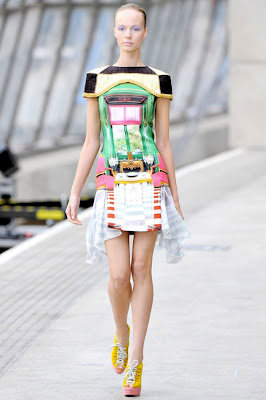Fashion in the Digital Age
If digital technology defines the current era for music, globalization defines it for fashion. The growing web of communications networks bringing the world closer together radically has redefined the ways in which fashion designers interact, trends spread throughout the world and the fashion industry organizes itself.
The impact of digital technologies has been far less earth-shattering on the fashion industry than on the music industry, as digital advancements drastically have eroded the music's economic and organization structures. Digital technologies have made the distribution of fashion design images instantaneous, and broadened their reach. They also have helped accelerate the production and distribution cycles for lower-priced, trendy, commodity goods, as evidenced in the discussion of H&M and Zara. However, unlike music, which now is divorced from any physical product, apparel and accessories have not entered fully into the virtual realm (thankfully, we've heeded our childhood morality tales of emperors and their clothes). Certainly, some avant-garde designers and computer engineers are attempting to fuse apparel and consumer technology, but these experiments still are relegated to the margins, more at home in museums and universities than on the street.Thus, while music has been transformed from a tangible product into a digital one, fashion remains a utilitarian, physical good. Technology may accelerate fashion's business processes, produce new ways of cutting patterns or develop a more breathable alternative to polyester, but it doesn't divorce the expression of the design from the design itself. Fashion is tactile and physical, necessarily rival and excludable, an indelible fact of its creation that separates it from music.Technology also creates a living archive of design, ideas and styles in the microscopic chronicling of the fashion industry by the media. It creates the opportunity for broader "sampling," as seen in the rapid production of Academy Awards dress knockoffs, but it is also a valuable tool for the social regulation of "theft," as described in the case of Nicolas Ghesquière at Balenciaga. As one journalist notes:
Designers have always looked to the past for inspiration; most famously, Christian Dior based his landmark New Look collection on memories of his mother, but in those days the past was not so minutely archived by the media and he could pass the belle époque off as his own.
The major change caused by digital technologies in fashion today is its globalization, which has drastically increased the already high tempo of the fashion world – accelerating production and consumption, and shortening the shelf life of trends. However, digital technologies also have a paradoxically inverse effect – sustaining the long-term shelf life of products and designs that may have disappeared much more quickly into fashion's fickle ether. Also thanks to new technologies and communications networks, the traditional dichotomy between consumer and producer, already fragile in America since the 1960s, has deteriorated even further. Fashion consumers, like music fans, have become much more adept at creative consumption, mixing high and low to create new street trends. Fashion consumers today think nothing of combining a Chanel jacket with Levi's jeans, Converse sneakers and a Hermès Birkin bag. Similarly, music fans increasingly are likely to combine several songs and albums into larger playlists, often played in "shuffle" mode, creating a controlled chaos in which R&B, opera and Celtic jigs may rub shoulders, producing unexpected and often aesthetically gratifying results.Clothing at one time served the exclusive purpose of shielding people from the elements – keeping us warm in colder climates, protecting us from the sun in tropical climates. With our current control over our physical environment – thanks to air-conditioning, indoor heating and commuting – our exposure to the elements is greatly reduced. As a result, traditional designs originally produced to protect their wearers, like those with socially denotative functions from other cultures, can be appropriated in new reconfigurations, detached from their original meaning or intent. Globalization, with its ever expanding circulation of images, defines this practice. Suddenly, images of apparel, both traditional and new, high end and low, are available effortlessly and instantaneously. The fashion industry and community borrow freely from this global circulation of images, remixing and reconfiguring them in a persistent and expanding commons.

